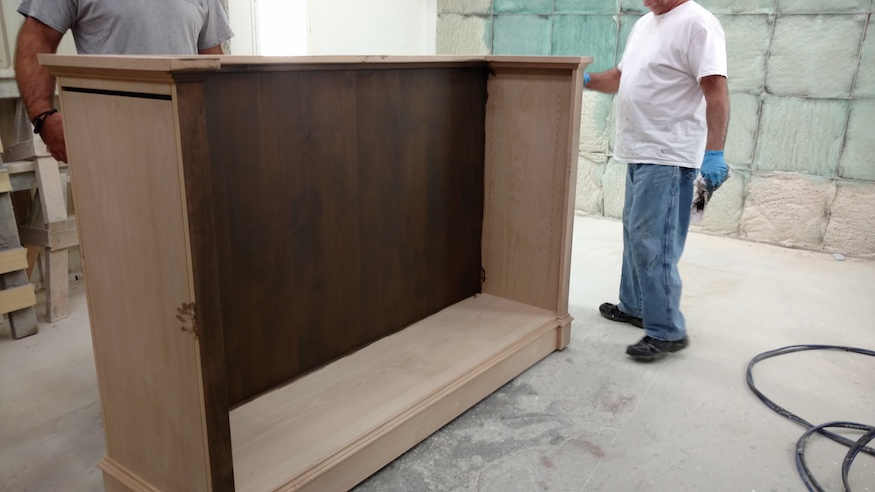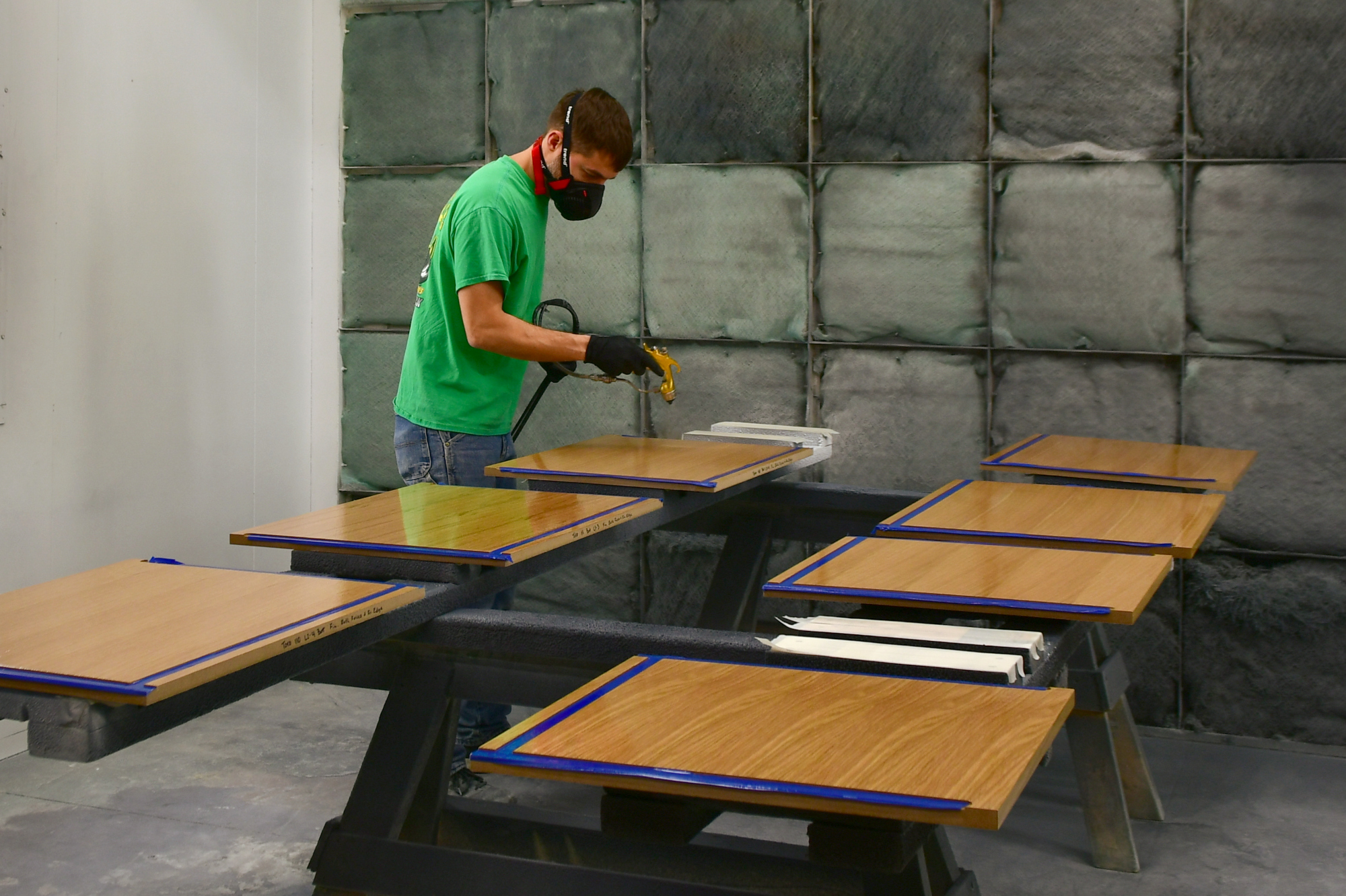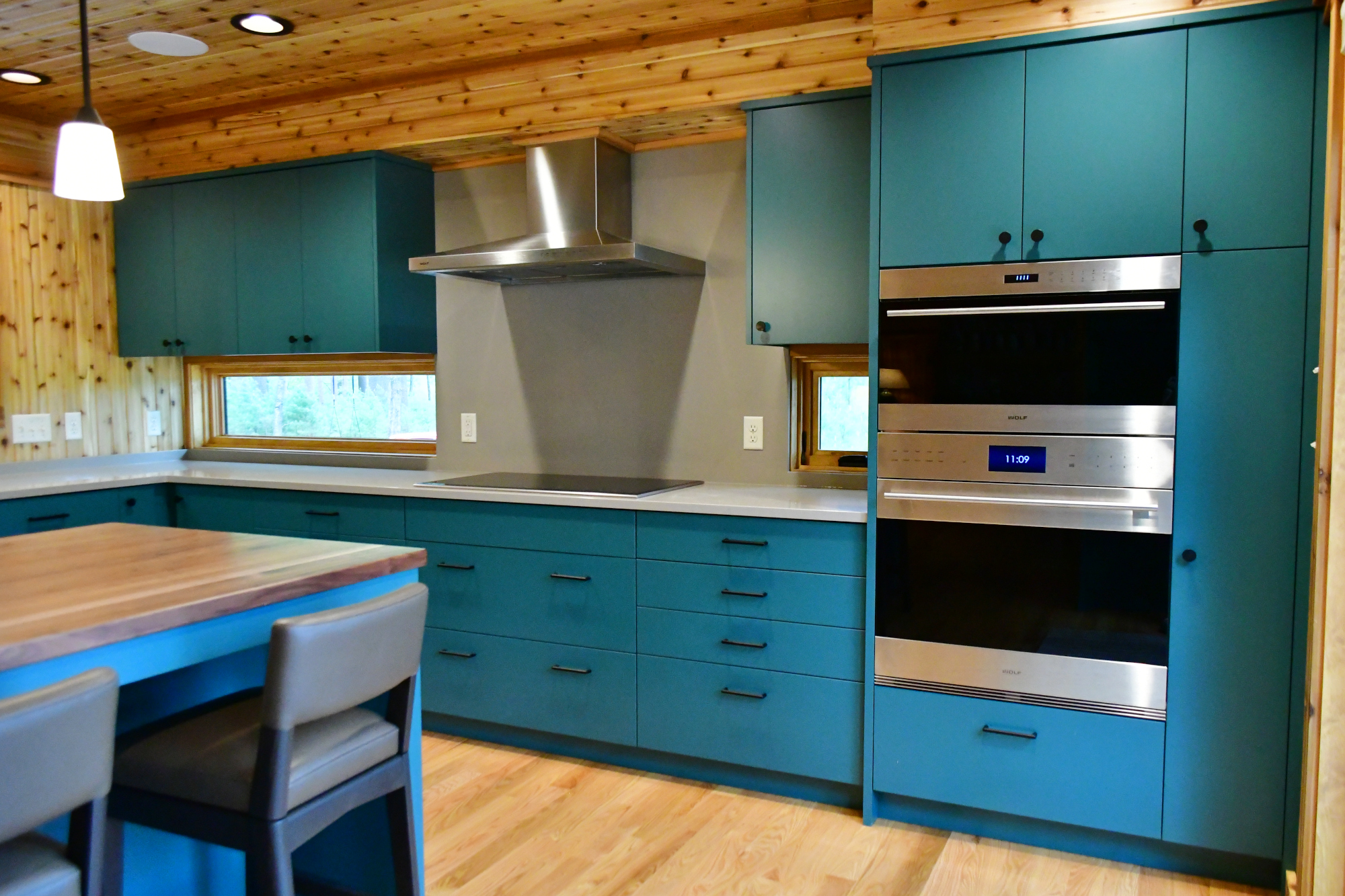
Stain Color
The most attractive quality of stain is the color it can achieve. Chances are, the last stain color you may have chosen was because of how it appeared — not because of its chemical makeup. But not understanding the differences in stain sand how each wood takes stain can lead to problems later on down the road. Most failures in staining come from the wrong choice in stain color rather than the wrong application.
The first thing to understand about staining wood is applying the same stain to both maple and walnut will result in a different color. Something else to understand is that stain acts differently on solid wood than it does on veneer. Typically, solid wood will stain a bit darker than veneer will. The qualities we look for in choosing the right stain include colorant, amount of colorant, binder, thickness, and the chemical makeup.
The stain product we use is Sherwin Williams Sherwood Stain.
A Brief Guide To Wood Stain Color:
- Pigment stains–Any stain containing pigment. Pigments do not stick to wood on their own so a binder must be present in this type of stain. Many “so-called pigments” contain dye.
- Dye Stains – Stains containing dye. Dye soaks right into the wood with the liquid it is in, so no binder is necessary. Dyes, besides binders, are added to pigment stains. These particular stains are called pigment stains, not dye stains.
- Wiping Stains—Contain pigments, binders, or both, and all contain a binder. That helps the pigment stick to the wood. Their slow drying time allows for more relaxed wiping. Most consumer stains are wiping stains.
- Oil Stains–Any stain that oil acts as a binder. They can be pigment, dye, or both types of stains.
- Water-Based Stains–Any stain that contains a water-based binder. They can be pigment, dye, or both types of stains.
- Varnish Stains–Any stain that contains a varnish binder, whether pigment, dye, or both.
- Lacquer Stains–Any stain that contains an alkyd varnish or lacquer binder. These dry quickly and are intended for spray applications.
- Gel Stains–Thickened stains that don’t run. It stays at the surface of the wood and only contains pigment.
Pigments
Two types of colorant, pigment and dye, make stain. Finely ground earth makes pigments. The “earth” can be natural or synthetic.
Synthetic materials now make up most pigments. Pigments are opaque, and manufacturers also use them to make paint colors.
Because the pigment is more dense than the liquid they’re suspended in, it settles to the bottom and has to be stirred frequently.
When stain is applied to the wood, pigments lodge into small holes like pores, scratches, or gouges. This is a great example of why we sand with the grain.
You can also build the thickness of pigments to make it act like a paint. Rather than wiping all the excess off, building requires some of the excess to be left on the wood. It kind of acts like a thinned down paint.

Dyes
Dyes are colorants found in coffee and walnut husks. Higher-quality synthetic materials can also produce dyes. Companies make synthetic dyes from petroleum, originally developing them for textiles.
In wood finishing, there are four types of dyes: water-soluble dyes, alcohol-soluble dyes, oil-soluble dyes, and non-grain-raising (NGR) dyes. Manufacturers typically sell the first three types in powder form, while they sell NGR dyes in liquid form.
- Water-soluble dyes are the best to use on cabinetry and furniture when applying with a brush or cloth. It has a longer “open” time which means you have plenty of time to wipe all the excess dye off.
- Alcohol-soluble dyes are used mostly for touch-ups and are brushed on to damaged areas.
- Oil-soluble dyes are used as a colorant in oil and varnish based stains and are rarely used on their own to color wood.
- NGR dyes are used when spraying directly onto the wood and leaving it or in combining dye with finish to make a toner.
Dye vs. Pigment based stain
Dyes are made from a chemical that dissolves in a liquid. When looking at the stain, everything that has settled to the bottom is the pigment and everything that remains in the liquid is dye.
In woodworking, pigments only fill pores that are big enough to hold them. This happens when the excess removed. However, dyes go all the way through the wood’s surface.
When pigment based stain is not removed, the pigments will conceal the wood. But when dye based stain is not removed, it appears transparent. Unlike dyes, pigments are always mixed with a binder to ensure its particles stick to the wood. Binders are a type of “glue” that holds pigment particles to the wood.
If pigments are used without a binder, the liquid can dry and the pigment particles may blow off the wood. There are four kinds of binders; including oil, varnish, lacquer, and water-base. Sometimes Shellac is used, but a dye, such as alcohol dye or NGR dye, must be added to it as a binder.

Applying Stain To Wood
There are two ways to apply stain to wood: apply wet stain and wipe it off before it dries, or apply the wet stain and leave it on. We typically reserve the latter option when using a spray gun. In wiping or brushing the stain on, the “wipe on, wipe off” application technique is preferred.
As long as the wood is prepared properly, this will help to achieve an even coloring. The main concern with the wipe on, wipe off method is ensuring the stain is wiped off before it starts to dry.
Some stains, like lacquer or solvent based dye stains tend to dry faster. Using these stains on a larger product may require having a second person to wipe off the stain as the first person applies it. Not to worry, though. If the stain spreads because you didn’t wipe it off in time, add a little more wet stain. This will help liquefy it again. Then, wipe it off right away.
Some woods, such as maple or beech, tend not to take a stain very well and can turn out blotchy when stained. In these cases, it is important to treat the wood with a “wash coat”. Wash coats limit how much a stain can actually penetrate the surface of the wood. Applying a wash coat to these particular woods takes vast knowledge and experimentation to get it right.
In larger production jobs, it is certainly worth the effort to ensure the quality of the stain. However, in small, maybe one-off pieces, a gel stain will give a little more predictable finish without the extra hassle of perfecting the wash coat.


